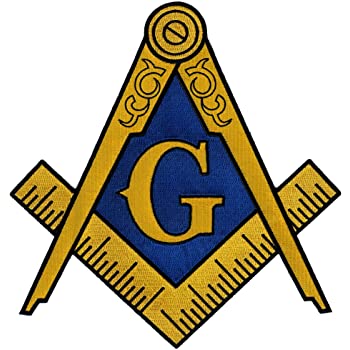While there are many symbols associated with Freemasonry, none are more universally recognizable than the square and compasses. It is well-known enough that even those who are not personally acquainted with the fraternity understand the connection when they come across it. Like many aspects of Freemasonry, the precise origins of this symbol are unknown. However, it is thought to have roots in the Medieval stonemasons’ guilds.
Of course, for modern Masons, the square and compasses symbol has a unique, profound meaning. It resides at the heart of Masonic lessons, beckoning all Brothers to live a life that is honest, true, and dignified. Any traveling man understands that when he sees this symbol, whether on the façade of a Masonic temple, the bumper sticker of a passing car, or a lapel pin of a colleague, he is in the company of friends.

What is the Square and Compasses?
This symbol consists of three core elements: the square, the compasses, and the letter “G.” The square and compasses are considered to be the tools of the architect and builder, which are used to teach the lessons of the symbolic lodge. To understand the meaning of the whole, it is necessary to break down the significance of each element.
The Square
The square, or builder’s square, is two equal flat-edged metal or wooden arms fixed that form a perfect “right angle” – or 90-degree angle. This tool is critical in stonemasonry because it allows craftsmen to draw and carve perfect square corners. Having perfectly square corners when building is critical to ensuring buildings do not lean and are structurally strong and sound. In Freemasonry, this symbol is used to teach lessons of morality. The notion that being “square” in your actions implies being honest and fair.
The Compasses
Most people likely know the compasses best from their geometry class. This tool consists of two legs equal in length that are fixed together at their apex by an adjustable hinge. In geometry, it is used for drawing perfect circles and arcs, a crucial element of architectural planning. In speculative Masonry, the compasses symbolize self-restraint and man’s ability to reign in his yearnings so that he may live a balanced life.
In the teachings of Freemasonry, the compasses are symbolically employed to draw a boundary line around our desires to avoid overindulgence and maintain moderation, the foundation of morality and wisdom. Taken together, the square and compasses can serve as a reminder that acting truly towards others and balancing one’s own needs will lead to a life of integrity.
Compasses vs. Compass
When looking at the term “Square and Compasses” itself, there is often confusion around whether or not “compasses” is correct as many believe it should be referred to as the singular “compass”. However, in Masonic Ritual, the correct usage is in fact “compasses”, as cited on page 162 of the Combined Ritual. Further, on page 173 of Mackey’s Revised Encyclopedia of Freemasonry (1929 edition), the entry under compasses reads:
“In Speculative Masonry, this important implement symbolic of that even tenor of deportment, that true standard of rectitude which alone can bestow happiness here and felicity hereafter. Hence are the compasses the most prominent emblem of virtue, the true and only measure of a Mason’s life and conduct. As the Bible gives us light on our duties to God, and the square illustrates our duties to our neighborhood and brother, so the compasses give that additional light which is to instruct us in the duty we owe to ourselves – the great, imperative duty of circumscribing our passions, and keeping our desires within due bounds.”
The Letter “G”
In America, the letter G is often found in the center of the square and compasses. It is less common in England and other parts of the world. Different people will ascribe different meanings to the letter G. For some it refers to Geometry and supports the Masonic lessons and symbolism associated with builders and architects, as well as the measurement and understanding of the order and perfection of the universe. Others see it as referring to God or the “Great Architect of the Universe,” which is an ecumenical term used by Masons of different faiths to refer to Deity as they pray together, each according to his own beliefs.
Freemasonry and Beyond
There is little doubt that the square and compasses is most frequently used in connection to Freemasonry. However, a number of other organizations also employ it in some variation or another, including the Order of Free Gardeners, the Latter Day Saints, and The Junior Order of United American Mechanics. While the square and compasses means different things to each, for Freemasons, the values this symbol stands for have remained unchanged for centuries. Today, it is a source of unity and inspiration for the members of the fraternity all over the globe, a beacon of truth, relief, and brotherly love.
Explore the other installments of our “Behind the Masonic Symbols” series, including The Forget-Me-Not, The Cornerstone, and The Apron.